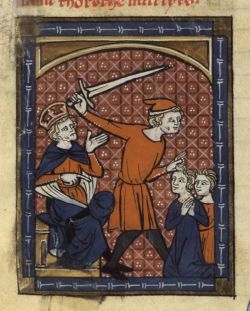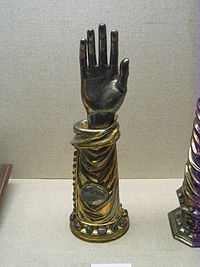- Gorgonius
-
Saint Gorgonius of Nicomedia 
The martyrdom of Gorgonius and Dorotheus, 14th century French manuscript.Martyr Born 3rd century AD Died 304 AD
NicomediaHonored in Roman Catholic Church Feast March 12 Saint Gorgonius of Nicomedia was a Christian martyr, part of the group Gorgonius, Peter Cubicularius and Dorotheus, who died in 304 AD at Nicomedia during the persecution of Emperor Diocletian.
According to Lactantius and Eusebius, Gorgonius held a high position in the household of the emperor. When the persecution began he was consequently among the first to be charged, and with his companions, Peter, Dorotheus and several others, was subjected to the most frightful torments and finally strangled.
According to one version of the legend, Diocletian, wishing to expose Christians in his household, ordered everyone to pay honor to the Roman gods; if they refused, they would be exposed as Christians. The first to be exposed was Diocletian's butler, Peter, surnamed Cubicularius ("valet, chamberlain"), who was strung up, his flesh torn from his bones. Two Christians, Dorotheus, an imperial chamberlain, and Gorgonius, an army officer, protested this treatment, and were also martyred, together with another official, named Migdonius. In the meantime, Peter was boiled or burned alive,[1] or “roasted on a gridiron.”[2]
Diocletian, determined that their bodies should not receive the honors which the early Christians gave the relics of the martyrs, ordered them to be thrown into the sea. The Christians nevertheless obtained possession of them and later the body of Gorgonius was carried to Rome.
Contents
Veneration
 Arm reliquary of St. Gorgonius at Minden Cathedral.
Arm reliquary of St. Gorgonius at Minden Cathedral.
From there in the 8th century the remains were translated by Saint Chrodegang, Bishop of Metz to the monastery of Gorze in Lorraine. Some of the relics were translated to Minden.[3]
Many French churches obtained portions of the saint's body from Gorze, but in the chaos of the French Revolution, most of these relics were lost. The feast of Gorgonius and his companions is kept on March 12.[4]
Gorgonius of Rome
Saint Gorgonius of Rome was an early Roman martyr commemorated on 9 September. Of this martyr all that is known is his name and that he was buried on a 9 September in the cemetery known as "Inter duas lauros" (between the two laurel trees) on the Via Labicana. Owing to the paucity of information about him, Saint Gorgonius of Rome, though still listed as a saint of the Roman Catholic Church, is no longer, since 1970, included in the Roman Catholic calendar of saints to be commemorated universally, wherever the Roman Rite is celebrated.[4][5][6] Some traditionalist Catholics continue to observe pre-1970 versions of the General Roman Calendar). All that is known of this Gorgonius is that he was commemorated on September 9 and that he is mentioned in the Depositio Martyrum (where it mentions Gorgoni in Lavicana; that is, he was buried on the Via Lavicana) and was venerated from at least around the end of the fourth century, but he was confused with the Gorgonius of Nicomedia, who was martyred with Dorotheus and Peter.[7] In the fourth century, Pope Damasus wrote some verses in honor of Gorgonius of Rome.[7]
Other Gorgonii
A third saint of this name was a member of the Forty Martyrs of Sebaste, otherwise known as the soldiers of the "Thundering Legion".
The different Gorgonii seem to have been frequently confused. The Catholic Encyclopaedia mentions others of the same name of whom virtually nothing is known and who have almost identical feast dates; these seem to be echoes of those named above.
Legacy
- San Gorgonio Mountain near San Bernardino, California was named by Spanish missionaries in honor of Saint Gorgonius in the 1800s.
References
- ^ "Santi Pietro (detto Cubicolario), Doroteo e Gorgonio" (in Italian). Santi e Beati. http://www.santiebeati.it/dettaglio/44690.
- ^ Saint Alfonso Maria de' Liguori, Victories of the martyrs; or, The lives of the most celebrated martyrs of the Church. Volume 9 of Ascetical works (EditorEugene GrimmPublisherBenziger Bros., 1888), 261.
- ^ Sabine Baring-Gould, The lives of the saints (J. Hodges., 1875), 131.
- ^ a b "Martyrologium Romanum" (Libreria Editrice Vaticana, 2001 ISBN 88-209-7210-7)
- ^ "Calendarium Romanum" (Libreria Editrice Vaticana, 1969), p. 138
- ^ "San Gorgonio di Roma" (in Italian). Santi e Beati. http://www.santiebeati.it/dettaglio/91951.
- ^ a b Alban Butler; edited by Paul Burns, Volume 9 of Butler's Lives of the Saints (Continuum International Publishing Group, 2000), 81.
 This article incorporates text from a publication now in the public domain: Herbermann, Charles, ed (1913). "St. Gorgonius". Catholic Encyclopedia. Robert Appleton Company.
This article incorporates text from a publication now in the public domain: Herbermann, Charles, ed (1913). "St. Gorgonius". Catholic Encyclopedia. Robert Appleton Company.Bibliography
- Oxford Dictionary of Saints (Oxford, 2004)
External links
- (German) Relic of Gorgonius
Categories:- 304 deaths
- Christian martyrs of the Roman era
- Anatolian Roman Catholic saints
- Saints from Anatolia
- 4th-century Christian martyr saints
- 4th-century Romans
Wikimedia Foundation. 2010.
